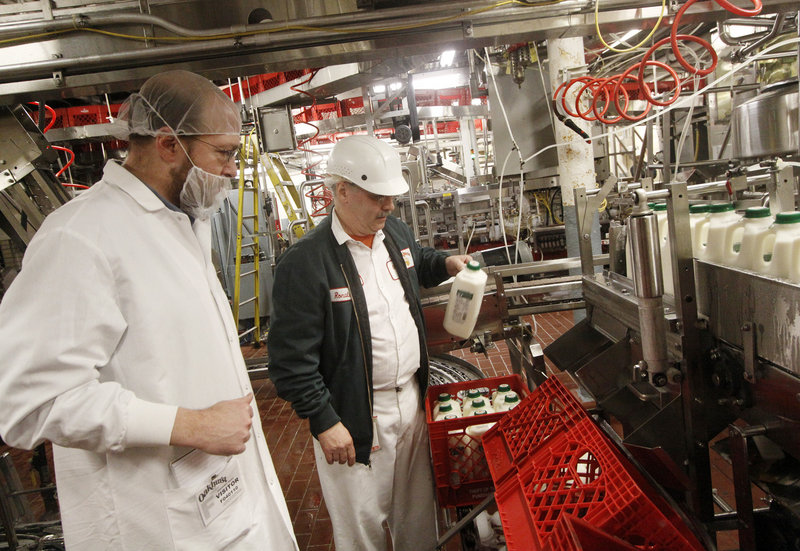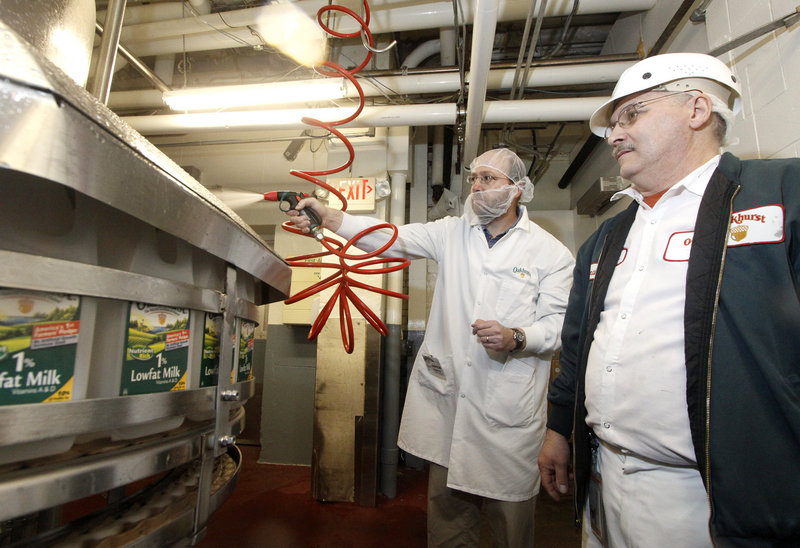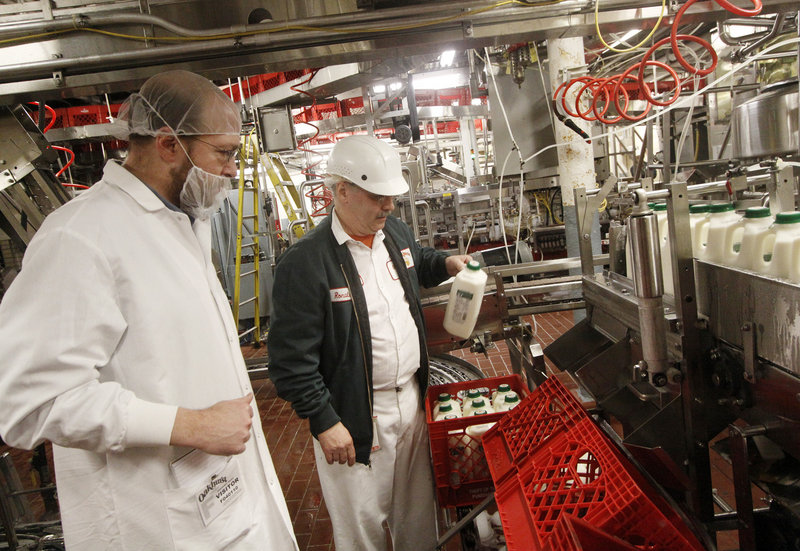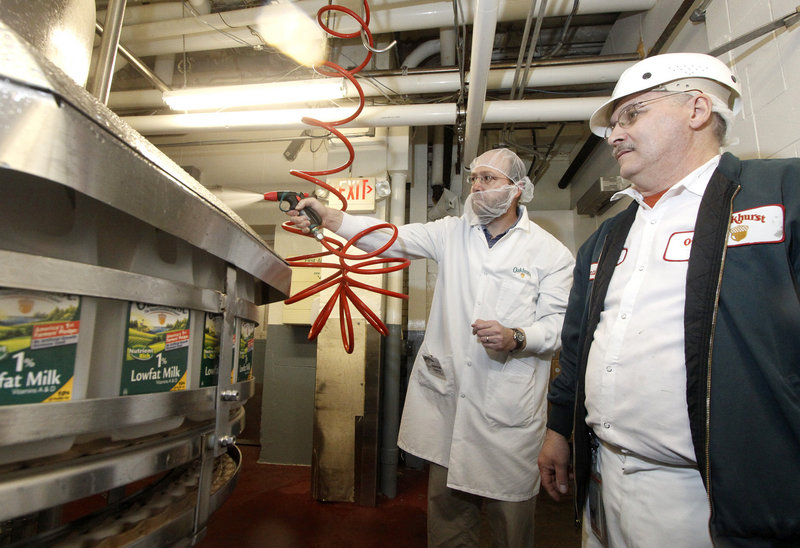PORTLAND — Pick a milk jug, any milk jug.
It sounded easy, but the half-gallon milk jugs in question were speeding by me on a multilevel conveyor belt while being filled with milk at the rate of 121 jugs per minute.
I was standing with Ronald Madore Jr., who has been filler operator at Oakhurst Dairy in Portland for 40 years. For him, pulling a random jug off the production line and checking it for any number of quality issues is something he could probably do in his sleep.
But I was wide awake as I tried to grab a half-gallon of 1 percent milk and felt it slip away down the line. Then I went to a two-handed approach and got one.
Madore had me weigh it, and he wrote down the weight and time of the check. Then I had to put the jug back into the speeding line of jugs. My fear was that I’d create a domino effect and topple thousands of jugs all over the plant. That would be too much spilled milk to cry over — I’d probably have to wail.
I quickly placed the jug on the line, and while it bounced against a couple of other containers, it didn’t fall.
Madore told me we now had to do a date check. And random leak checks, and label checks, and product number checks.
And all of these had to be done every 15 minutes.
Not to mention we’d be refilling the cap dispenser and sanitizing the filler machine with a spray-on solution just as often.
“There’s really not a lot of downtime,” said Madore, as he weighed a half-gallon. “We’ve got to keep the line moving.”
TIME FOR A TASTE TEST
Madore, who is deaf, was explaining his job to me last week with the help of a sign-language interpreter, Maurita Marr of Pine Tree Society Interpreting Services in Scarborough.
When Madore needed help from co-workers, he’d use basic hand signals that were easily understood. If he had to leave his filler machine for even a minute, he’d look at a co-worker and point to his eyes to indicate he wanted them to watch his line of milk jugs.
Madore was in constant movement while I followed him. The filler machine looks like a giant carousel with 26 valves that lower themselves onto moving milk jugs to fill them. Above the filler is a compartment filled with plastic caps, so the machine can cap the jugs once they are filled.
Madore is responsible for programming the machine, telling it how many jugs to fill and what kind of milk to fill them with. Oakhurst Dairy processes milk from 75 Maine farms and turns out about 1.1 million pounds of the stuff daily for sale in stores. The plant runs 24 hours a day, with someone manning the filler machines around the clock.
As the end of a production run of 1 percent half-gallons approached, Madore had to begin planning for the next run, of skim milk. So he had to calculate how many more jugs of 1 percent he’d fill with the milk still left in the hose that connects to the filler. He had maybe three-quarters of a jug of 1 percent milk left over, which is pretty good, he said.
When he started filling jugs with skim milk, he told me to grab one and take it upstairs to the break room for a taste test.
Yes, it’s a requirement for filler operators to taste-test the milk every time they change to a different kind. The milk was good, I thought, more like real milk than a lot of skims I’ve had. But other than that, I had no idea what I was tasting for.
Madore told me his taste buds are searching for anything wrong with the taste. Maybe some leftover chocolate flavor got in. Maybe he can taste some residue of cleaning solution, or maybe it’s just not right.
But this batch was right, so we put the opened container in the break room refrigerator for employees.
CATCHING SMALL MISTAKES
Back near the filler machine, Madore had me walk down the line, hop over a floor-level conveyor belt and grab a red crate of filled and capped milk jugs. He told me to flip the crate on its side, wait one or two minutes and carefully look for even the smallest leak.
I waited and looked.
With nine white milk jugs crammed against each other, all I could see was white. It was all a blur to me.
But Madore, who was standing 10 feet away, spotted a drip. After I focused my eyes, I saw it, too.
“I’ve got to go call this in right away,” said Madore, grabbing a jug so he could get the number on the bottom. “I’ve got to call the bottle room so they can fix this.”
Madore later explained to me that a slow leak can be caused by the smallest imperfection in the plastic bottle or cap, and that the container makers on site will tweak their process to correct the imperfection.
“If there’s a leak in the store, people are going to complain,” said Madore. “And I don’t want that.”
Staff Writer Ray Routhier can be contacted at 791-6454 or at:
rrouthier@pressherald.com
Send questions/comments to the editors.







Success. Please wait for the page to reload. If the page does not reload within 5 seconds, please refresh the page.
Enter your email and password to access comments.
Hi, to comment on stories you must . This profile is in addition to your subscription and website login.
Already have a commenting profile? .
Invalid username/password.
Please check your email to confirm and complete your registration.
Only subscribers are eligible to post comments. Please subscribe or login first for digital access. Here’s why.
Use the form below to reset your password. When you've submitted your account email, we will send an email with a reset code.